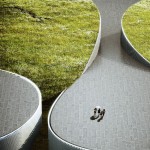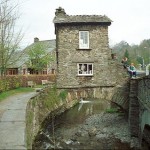Introduction
 |
| The fixed 28mm focal length you get with the Leica Q can be versatile and creative, but it can also allow for basic images like this to help set the scene. Photo by Carey Rose, processed to taste from Raw. F8 | 1/125 | ISO 320 |
Between the timber industry and a reputation for organized crime and racketeering, early Portland, OR is a town that, like a number of other Pacific Northwest settlements, started off a little rough. But today, Portland has grown into and is known for being one of the most progressive cities in the country. This rise from rags to prominence is at least vaguely reminiscent of the rise of mirrorless technology in cameras, though the latter has happened much more rapidly. What were once laggy, poor-focusing and incredibly power-hungry devices have evolved into technological powerhouses, playing host to some of the latest and greatest innovations in camera technology. The Leica Q is, unarguably, one such mirrorless camera.
Portland has also been nicknamed ‘Bridgetown,’ for its many crisscrossing bridges slicing through the urban landscape. Rather appropriately, then, the Leica Q is a bridge of sorts for me. It is the first mirrorless camera I’ve brought with me to shoot a wedding alongside my usual full-frame DSLRs, and the first mirrorless camera I’ve used that performs very nearly at a level I expect from my well-worn and bulky workhorses.
Keep in mind: the Leica Q was used in conjunction with two additional cameras for this wedding, but all images in this post are from the Q. The 28mm focal length it offers can be versatile, but definitely has a ‘look’ and it can’t replace a good normal or telephoto lens for some variety in the full final take.
Fitting in the kit
I will normally shoot an entire wedding on two full-frame DSLRs, and trade between 35mm, 50mm and 85mm lenses (with an 80-200mm F2.8 coming out for the ceremony only). Adding the Leica Q to the mix added a little extra bulk, sure, as I was now carrying three cameras instead of two. But it meant almost no lens swapping, as I could have the 35mm focal length covered more or less by the Q’s excellent 28mm F1.7 Summilux lens, and keep the 50mm and 85mm glued to the other cameras. The result was that I probably looked a little ridiculous to most of the guests, but having three F1.7-and-wider lenses at my disposal allowed me to make the most of any situation I found myself in.
 |
| The Q managed to nail focus on the subject’s head despite dim backlighting and fairly low contrast. Why can’t all CDAF systems work this well? Photo by Carey Rose, processed to taste from Raw. F1.7 | 1/125 | ISO 2500 |
I set up the Q to shoot in aperture priority with auto ISO, and a minimum shutter speed varying from 1/60 to 1/250 depending on the situation. I kept it in Single-AF and recorded RAW+JPEG for the whole shebang.
What worked, what didn’t
The Q’s autofocus system is not only accurate, but it is close to phase-detect fast (even though it’s a contrast-detect system). I kept it in Single-AF for the day because it just worked so well. The four-way controller on the rear made it a breeze to quickly change the focus point position, and with the 28mm focal length, focus-and-recompose shooting didn’t make too much of a difference in critical sharpness. The few times I wanted to use Face Detection (such as handing the camera off to somebody else to take a shot), I found it was a bit of a pain to dive into the menus to change it. This could be mitigated if you could assign something autofocus-related to either of the customizable function buttons on the rear, but you can’t. At least the menus are fairly well-sorted.
 |
| Though its DNG files may have less post-processing latitude than other camera systems, the Q can hold its own in low light as long as you pay careful attention to your exposure. F1.7 | 1/125 | ISO 5000 |
Speaking of buttons, the buttons, controls and dials are all easy to feel with your eye to the finder, and with enough positive action that there’s never any question of whether or not you hit something. So that’s a good start. However, for a camera focused so heavily on stills, it would be nice to at least have the option to reassign the ‘Movie Record’ button to something else. Also, when you are shooting in Auto-ISO, you can twiddle the shutter speed dial to override the minimum shutter speed you’ve selected, but then the rear control dial switches from controlling exposure compensation to controlling the shutter speed in 1/3 stops. You can mitigate this by assigning the ‘FN’ button on the back to ‘exposure compensation,’ but it would be nice if the control dial operation was more consistent or customizable. Also, the LCD and EVF will give you an accurate preview if you skew to under-exposure, but in low light, dialing in some intentional over-exposure would not adjust the preview at all, which was more a minor irritation than an impactful problem.
 |
| Skin tones (and color in general) are great on the Q in Raw mode, and the 28mm lens is well corrected to avoid tons of distortion at the edges. Even if it wasn’t, these two gents would be too distracted by their matching suit jackets to notice wide angle distortion anyway. Photo by Carey Rose, processed to taste in Raw. F1.7 | 1/125 | ISO 2000 |
If you prefer not to use buttons, you can use the touchscreen for a good number of functions, including swiping and zooming in playback, and touch-to-focus and shoot options. However, touch-to-focus only focuses once, where you touched. Half-pressing the shutter does not refocus, and you can’t now use the four-way controller to move the point around if you then want to shoot from the EVF. You’ll have to go back into the menus and enable another focus mode. And if you just don’t want to mess with the touchscreen (I had more than a few accidental swipes trying to enter playback mode to show images to people), there is no menu option to completely disable it.
 |
| The lens may be fairly wide-angle, but the macro functionality allows you to get up close and personal with some detail shots and still get rid of most of a distracting background. Photo by Carey Rose, processed to taste from Raw. F2.8 | 1/500 | ISO 640 |
Now, it may sound like I’m being hard on the camera, but in the real world, these were fairly small problems (and all could conceivably be fixed with a firmware update – hint hint, Leica). In fact, there was only one real issue that seriously plagued my experience with the Q. Although the Q’s battery life is great for a mirrorless camera, it’s not so good that I felt like I could just leave the camera on constantly. But that wasn’t the real problem because the start-up time is so fast. No, the problem was that, after shooting a burst and moving on, I would instinctively twiddle the power dial to ‘Off.’ The camera screen and live view stays on until the buffer is cleared, and only then will the camera fully shut off.
 |
| Would AF tracking have worked better than Single-AF for this shot? Maybe, but I didn’t want to dig into the menus to change it. Photo by Carey Rose, processed and cropped to taste from Raw. F2 | 1/125 | ISO 2500 |
However, if I wanted to resume taking photos, I would turn the switch back on, but the camera would be locked and ignore any and all inputs until it had finished the previous burst to the card. Then it would turn off, then turn itself back on. This process, despite using the fastest SD card money can buy, would take as long as 20-30 seconds.
None of this happens if you leave the camera on after you take a burst – you can resume taking photos or explore the menu system as the camera does its writing (but you can’t immediately enter playback mode when the buffer fills, as you can on many DSLRs). In the end, it’s a strange behavior that can be avoided, but was still upsetting since I’d developed this ‘switch off between shots’ habit based on the battery life of other mirrorless cameras.
The results
Despite all the little issues I discovered above, the Leica Q is a fantastic camera. The only reason I experienced all those little issues to begin with is that I gave this camera no leeway. I used it just like an established full-frame DSLR system, and expected it to perform like one. For the most part, it did. Hell, if Leica made another Q with a fixed 50mm or 85mm lens, I’d have a hard time not selling off most of my DSLR gear and switching over. If only my DSLRs were worth their weight in gold. Or maybe little red dots.
 |
| It may not be an ‘action camera’ per se, but the burst modes on the Q give it some caught-moment chops. Photo by Carey Rose, processed and cropped to taste from Raw. F2.8 | 1/500 | ISO 500 |
There are numerous reports to the contrary, but I found the camera quite comfortable to hold (even without the optional grip). My hands didn’t get sweaty, and the camera didn’t get too slippery. The lens is stunningly sharp, and the out-of-focus renderings are gorgeous. The sensor may not be up to Sony standards of dynamic range, but noise performance is great if you don’t mind a little grain (I don’t) and you nail your exposure. I managed almost 900 shots on the equivalent of just over one battery (I did one battery swap after a bar disappeared, out of old habits). The camera is built incredibly well, and is dense but light enough that I didn’t have a neck cramp after hours of shooting. It may not be weather-sealed, but it feels like it can take a beating.
I should also call your attention to the fact that every single image in this write-up is processed from Raw. Of course, I always shoot Raw for paying gigs, but out of curiosity, I shot Raw + JPEG (and there’s no option to shoot Raw only anyway) on the Q. I found the JPEG engine, particularly the colors and skin tones that resulted from it, to be pretty unpleasant (especially next to an adjusted Raw file). So if you’re a JPEG shooter, be prepared to start a new Raw habit. Also, using the ’embedded’ DNG profile versus the Adobe Standard profile in Adobe Camera Raw does something weird to your white balance settings – I had to boost mine about 1500-kelvin over normal when using the embedded profile.
 |
| Out-of-camera JPEG |
Processed to taste from Adobe Camera Raw |
For the out-of-camera JPEG image above, the Q was set to sRGB color space, with contrast, saturation and sharpness all set to standard. That’s the extent of JPEG adjustment parameters in-camera. For the processed image, I used Adobe Camera Raw with the Adobe Standard color profile, making fairly controlled adjustments to the white balance, highlights, shadows, whites, blacks, clarity and vibrance. The exposure was F1.7, 1/250, ISO 320.
As far as performance, with the exception of the strange buffer / power switch issue I highlighted above, I never found myself waiting for the camera. Whether I’m shooting weddings, events, street or environmental portraits, that responsiveness in and of itself is an absolutely paramount requirement. And if you consider the cost of a pro-level (not enthusiast) full-frame DSLR and accompanying fast-wide lens of a similar caliber to this 28mm F1.7 Summilux, the Q isn’t too terrible a value proposition, either.
 |
| Party on: if you like the focal length, the Q can handle just about anything you throw at it. Except maybe a bucket of water, or a beer. Photo by Carey Rose, processed and cropped to taste from Raw. F1.7 | 1/250 | ISO 400 |
In short, the Q is the fixed-lens digital camera I’ve been waiting for. If you work with this focal length and can look past some of its smaller issues, you owe it to yourself to give the Q a try.
Articles: Digital Photography Review (dpreview.com)

























You must be logged in to post a comment.